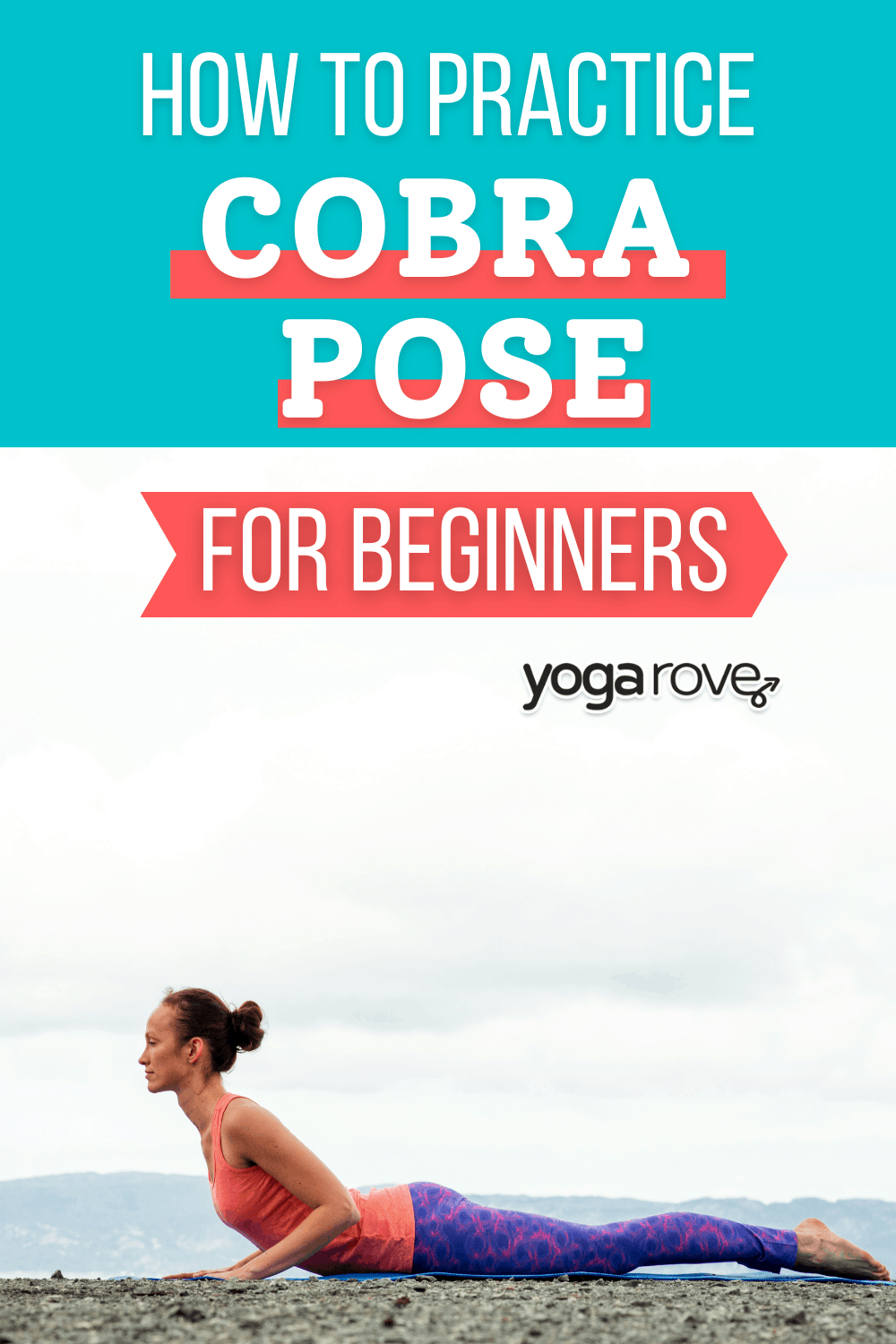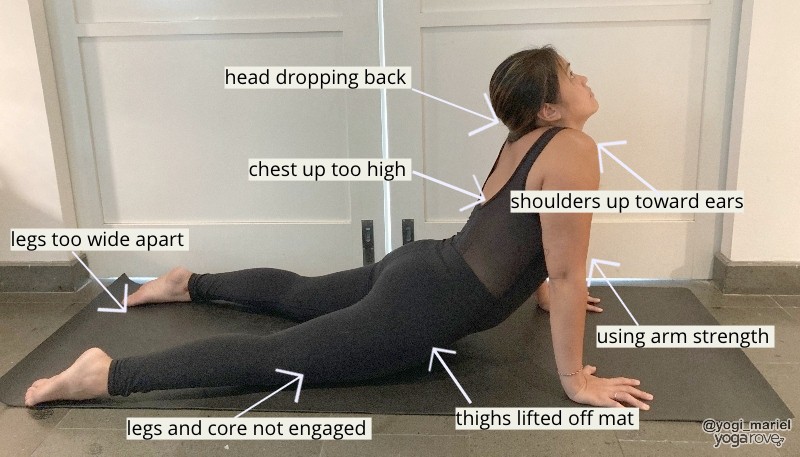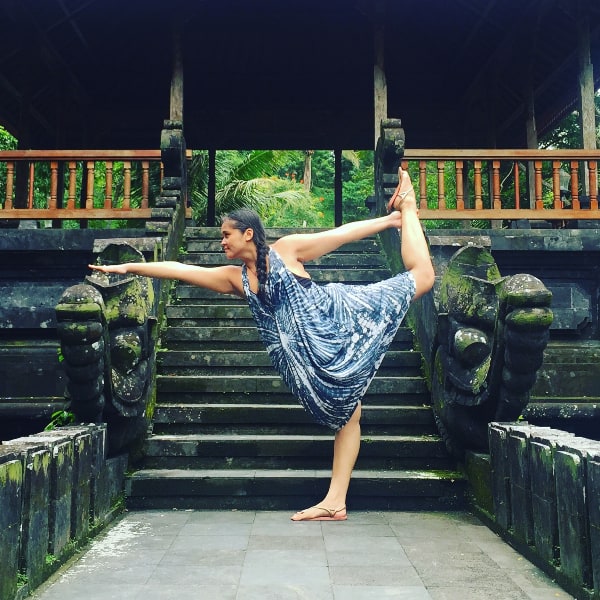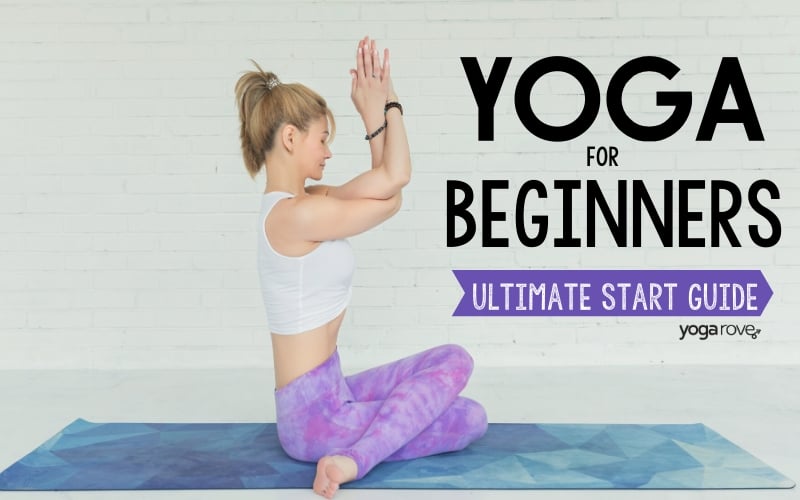This post may contain affiliate links. Please read our disclosure for more info.
If you have practiced Vinyasa yoga and Sun Salutations, then Cobra pose is definitely a posture that you are familiar with. Cobra is an excellent back strengthener and chest opener. It can feel amazing in your body when practiced safely with the proper alignment.

Yoga postures are often named after animals. This backbend mimics the shape of a cobra arching itself upward. Different from Upward Facing Dog which is a deeper and more active backend, Cobra pose is an alternative to practice if you are taking a modified or gentler vinyasa flow.
Benefits of Cobra Pose
Cobra pose is usually practiced during Sun Salutations or during the backhanding portion of practice. It is known as a heart-opening posture as it opens up the chest, shoulders, and the front of your upper body. Practicing heart openers like Cobra pose holds countless benefits. Some benefits of Cobra pose are:
- Opens up your chest and shoulders
- Strengthens your arms, back body, core, and pelvic muscles
- Stimulates organs in the abdomen
- Improves the circulation of blood and oxygen
- Relieves stress and tiredness
- Opens your heart
- Releases your lower back
Warming Up for Cobra Pose
Heart openers can feel very opening and freeing in the body, but for some yogis, they can also feel very intense and tight. As part of the Sun Salutation sequence, Cobra is practiced after a low push-up or Chaturanga.
Sun Salutations: A few rounds are often practiced during the beginning of practice. Take it easy and slow if you feel tightness when you practice your Cobra. Sun Salutations warm up the entire body. The poses before Cobra pose warm up your body for this backbend and heart opener.
Your entire practice: Sometimes Cobra is practiced toward the end of class during the backhanding portion of class. It may be one of the earlier backbends that you practice before deeper ones such as Bow pose or Wheel pose. By then, your body should be warmed up enough to feel open and spacious in the posture.
How to Practice Cobra Pose
You don’t have to practice Cobra pose within your Sun Salutation. Feel free to come into the posture when you need to open your front body or release tension in your lower back.
To practice Cobra pose:
- Lie down lengthwise on your mat with your belly down and your forehead on the mat
- Place your palms down on the mat in the same line of your ribcage
- Spread your fingers wide and press your palms down
- Engage your legs and lift your kneecaps off the mat.
- Press the tops of your feet on the floor
- Inhale to lift your chest and head off the floor
- Engage your core and take your elbows in closer to your ribcage
- Without using too much arm strength, lift your chest a little higher, roll your shoulders down your back, and relax your shoulders
- Look straight in front of you and keep your chin leveled
- Focus on lifting your heart up
- Stay for 5 deep breaths
Common Misalignments
When you practice Cobra pose in a Sun Salutation, it always comes after low push up or Chaturanga. Sometimes Cobra can feel like a break after such a challenging pose. You may feel like you want to relax in the pose, which in turn can result in misalignment in the body.

Here are some common misalignments to Cobra pose:
- Not engaging your legs and core: Some yogis press into their hands and use arm strength instead of engaging their legs and care. Your lower back area is quite vulnerable. It is important to engage your muscles surrounding it for protection. If Cobra pose is practiced without muscle engagement, your lower back may start to feel discomfort.
- Lifting your chest too high: This pose is all about actively lifting your chest to engage chest and back muscles, not to lift your chest as high as possible. Don’t worry so much about how high off the ground you get. Instead, focus on engaging and straightening your muscles with proper alignment.
- Dropping your head too far back: While it might seem like lifting your head up would intensify your stretch, it actually just strains your neck. There is no benefit throwing your head back and looking up toward the ceiling. It is more important to keep your chin leveled and gaze forward.
- Lifting your knees off the ground: Upward Facing Dog is similar to Cobra pose, but is practiced with your knees and thighs off of the ground, and with upper body effort and strength. In Cobra Pose your hands only gently press into the mat and the only parts that are lifted off the ground are the chest and head.
- Elbows flaring out: Keep your elbows in close toward your body and focus on using your upper body strength instead of your arm strength.
Modifications
While Cobra pose is a stepping stone to Upward Facing Dog, it is still a deep backbend and may require some modifications. Try some of the modified variations below:

Hand placement: Take your hands further away from your ribcage if traditional Cobra pose hurts your lower back. Place your hands under your shoulders and press down lightly as you lift your chest up. Lift your chest very slightly and keep your gaze forward. This version as not as deep as Cobra and is also known as Baby Cobra pose.
Use a block: Place a block between your thighs to ensure proper leg engagement. Lie down on the floor, place a block between your upper thighs, and hug your inner thighs together to squeeze the block. Keep your legs strong as you enter the posture.
Modify your Sun Salutation: If you struggle with the transition from Chaturanga to Cobra pose, practice a modified Chaturanga with your knees on the floor. This will allow for a more controlled entrance with better alignment into your Cobra pose.
Tips for Beginners
- Use props: If it is challenging to keep your legs together and engaged, use a block or a strap. You can use your strap around your feet or your upper thighs to prevent your legs from separating. Or, place a block in between your inner thighs. Focus on engaging your core and back muscles to lift your chest as you press your inner thighs together.
- Forget about how high your chest lifts: You’re doing everything right if you’re feeling a chest and back stretch in Cobra pose. Sometimes it can feel tempting to compare yourself to your yogi friend who’s chest is lifted high off the mat. However, concentrate on engaging your back muscles and opening your chest instead of the height of your chest.
- Use your core: You may think that because Cobra pose is a backbend, all you need to engage is your upper body or back muscles. However, a strong core is necessary in this posture and will protect your lower back. Even though your belly is on the mat, draw your belly button in toward your spine as you lift your chest up and keep your legs engaged.
Variations in Cobra Pose
Try these back bending variations next time you are in Cobra pose:

Sphinx pose: Practice the same shape with the support of your elbows instead of your hands. Place your elbows and palms on the mat with your fingers pointing toward the top of your mat. Hug your elbows in close to your ribcage and root your forearms and palms on the floor. Inhale to lift your head and chest off the mat, roll your shoulders back and down, and gaze forward.
Lift your hands off the mat: Instead of keeping your palms flat on the mat, lift your hands a few inches off the floor. You can try this modification if you feel that you are using a lot of your arm strength or pushing down on the mat intensely. This modification helps you to focus on using the strength of your back, legs, and core.
Interlace your fingers: Looking for a little extra opening in your chest and heart area? Try this modification by interlacing your fingers at your low back as you lift your chest off the mat. Squeeze your palms together tightly and move your hands away from your lower back. Relax your shoulders and keep the focus on lifting your heart up toward the ceiling.
Contraindications
If you are pregnant or had abdominal surgery recently, skip this pose and stick with supported bridge pose on your back. If you recently had a back, arm, neck, or shoulder injury take caution when practicing this pose and ask your yoga teacher for any modifications that you can take.
Looking to find more space in your chest and build your upper body and back strength? Cobra pose is definitely a posture to practice regularly. With different modifications and variations, you can be sure to find comfort in this heart opening backbend. Be sure to listen to your body, take it slow, and you will be curling your chest up in a cobra shape in no time!






